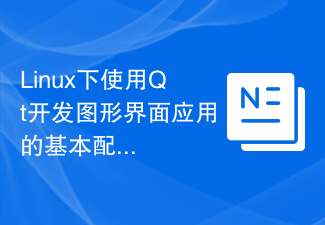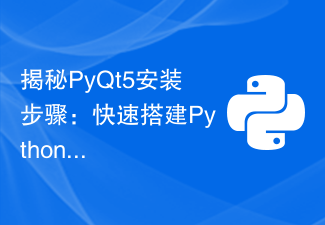 Backend Development
Backend Development C++
C++ How does C++ support graphics and user interface development for embedded systems?
How does C++ support graphics and user interface development for embedded systems?C supports embedded system GUI development by providing a series of GUI libraries (such as Qt, wxWidgets). These libraries ensure real-time response, low memory footprint, code reusability and portability. Practical examples demonstrate the use of C in creating embedded dashboard instruments, including setting up the GUI and main function.

C How to enhance the graphics and user interface development of embedded systems
C occupies a pivotal position in the development of embedded systems , which provides powerful features for graphics and user interface (GUI) development. This article will explore how C supports GUI development for embedded systems and provide a practical case.
C’s GUI Library
C provides an extensive GUI library to simplify embedded system development. Some popular libraries include:
- Qt: A cross-platform GUI library that provides rich components and APIs.
- wxWidgets: A lightweight cross-platform GUI library that is easy to port to embedded platforms.
- FLTK: A lightweight GUI library designed for embedded systems.
- Nano-GUI: A lightweight GUI library for embedded systems and low-power devices.
Features for embedded systems
C Support GUI development for embedded systems provides the following features:
- Real-time: C is a compiled language that produces efficient code to ensure timely response to GUI events in embedded systems.
- Low memory footprint: The C GUI library occupies a small memory space and is very suitable for resource-limited embedded devices.
- Code reusability: C supports code reuse, allowing developers to use the same GUI components in different embedded projects.
- Portability: The cross-platform nature of C enables developers to deploy GUI applications on different embedded platforms.
Practical Case: Embedded Dashboard Instrument
We will use the Qt GUI library to create an embedded dashboard instrument to demonstrate the use of C in GUI development practical application.
- Setting GUI:
#include <QApplication>
#include <QWidget>
#include <QDial>
class InstrumentCluster : public QWidget {
public:
InstrumentCluster() {
// 创建刻度盘
QDial *dial = new QDial(this);
dial->setRange(0, 100);
dial->setFixedSize(100, 100);
}
};- Main function:
int main(int argc, char *argv[]) {
QApplication app(argc, argv);
InstrumentCluster cluster;
cluster.show();
return app.exec();
}In this example, we create an embedded dashboard gauge that contains dials. Compiling and running the program will display a GUI with dials on the device.
Conclusion
C plays a vital role in GUI development of embedded systems. It provides a series of GUI libraries that allow developers to create efficient, low memory usage and portable GUI applications. Through this guide and practical examples, we show how C can enhance GUI development capabilities for embedded systems.
The above is the detailed content of How does C++ support graphics and user interface development for embedded systems?. For more information, please follow other related articles on the PHP Chinese website!
 C++语言在嵌入式系统中实现高效能无线通信功能的方法Aug 26, 2023 am 09:23 AM
C++语言在嵌入式系统中实现高效能无线通信功能的方法Aug 26, 2023 am 09:23 AMC++语言在嵌入式系统中实现高效能无线通信功能的方法嵌入式系统是指集成了计算机硬件和软件的特定功能系统。在许多嵌入式系统中,无线通信是一个关键的功能要求。本文将探讨如何使用C++语言在嵌入式系统中实现高效能的无线通信功能,并提供相应的代码示例。在嵌入式系统中,无线通信通常使用射频模块和传输协议来实现。针对不同的应用场景和要求,可以选择不同的射频模块和传输协议
 C++在嵌入式系统开发中的软件测试与调试功能实现技巧Aug 25, 2023 pm 06:48 PM
C++在嵌入式系统开发中的软件测试与调试功能实现技巧Aug 25, 2023 pm 06:48 PMC++在嵌入式系统开发中的软件测试与调试功能实现技巧嵌入式系统在当今的科技领域发挥着越来越重要的作用,它们被广泛应用于智能家居、汽车、医疗设备等领域。然而,在嵌入式系统开发过程中,软件测试与调试是必不可少的环节,因为嵌入式系统的错误可能导致严重的后果。本文将介绍如何使用C++语言实现嵌入式系统的软件测试与调试功能,并提供一些代码示例。一、测试框架选择在嵌入式
 超全!Python图形界面框架PyQt5使用指南!Apr 13, 2023 am 08:43 AM
超全!Python图形界面框架PyQt5使用指南!Apr 13, 2023 am 08:43 AM常见GUI框架 PyQt5:Qt是一个跨平台的 C++图形用户界面库。QT一度被诺基亚拥,后出售给芬兰的软件公司Digia Oyj。PyQt5是基于Digia公司Qt5的Python接口,由一组Python模块构成。PyQt5本身拥有超过620个类和6000函数及方法。在可以运行于多个平台,包括:Unix, Windows, and Mac OS。 Pyside6:Pyside是QT公司官方提供的Python包,上一版本为Pyside2,对应的是QT5,最新版命名规则进行了调整,更改为Pysid
 Linux下使用Qt开发图形界面应用的基本配置指南Jul 05, 2023 pm 12:01 PM
Linux下使用Qt开发图形界面应用的基本配置指南Jul 05, 2023 pm 12:01 PMLinux下使用Qt开发图形界面应用的基本配置指南一、引言Qt是一套跨平台的C++库,它提供了丰富的图形界面开发组件,以及许多其他的功能模块,适用于开发跨平台的图形界面应用程序。本文将介绍如何在Linux系统下进行Qt开发,并给出一些基本的配置指南和代码示例。二、安装Qt开发环境下载Qt在Qt官方网站上(http://www.qt.io/)下载合适的Qt
 禁用CentOS发行版的图形界面有哪些方法?Jan 03, 2024 am 09:18 AM
禁用CentOS发行版的图形界面有哪些方法?Jan 03, 2024 am 09:18 AM很多家中使用linux的朋友,都是使用虚拟机来搭建linux,能给虚拟机分配的资源是有限的,如果不关闭一些服务,那么系统就会比较卡。这些服务中,图形界面就是首当其冲要关闭的服务。下面我列举下我用过的三个发行版关闭图形界面的方法。1.CentOS5、6系列。打开/etc/inittab文件,在id:5:initdefault这一行中,将其改成id:3:initdefault:。重启系统就可以生效,如果想立即生效,可以命令行输入“init3”;2.CentOS7系列。ln-svf/li
 提高C++编程技巧,实现嵌入式系统的多传感器数据处理功能Aug 25, 2023 pm 01:21 PM
提高C++编程技巧,实现嵌入式系统的多传感器数据处理功能Aug 25, 2023 pm 01:21 PM提高C++编程技巧,实现嵌入式系统的多传感器数据处理功能引言:随着科技的不断发展,嵌入式系统在各个领域中得到广泛应用。在许多嵌入式系统中,多传感器数据处理是一个常见的任务。为了更好地处理这些传感器数据,提高C++编程技巧是非常重要的。本文将介绍一些实用的C++编程技巧,并结合代码示例,演示如何实现嵌入式系统的多传感器数据处理功能。一、使用合适的数据结构在处理
 揭秘PyQt5安装步骤:快速搭建Python图形界面!Feb 20, 2024 pm 12:18 PM
揭秘PyQt5安装步骤:快速搭建Python图形界面!Feb 20, 2024 pm 12:18 PMPyQt5是一个强大的Python模块,可以用于创建图形界面应用程序。本文将揭秘PyQt5的安装步骤,并提供具体的代码示例,帮助读者快速搭建Python图形界面。第一步:安装Python在开始安装PyQt5之前,我们需要先安装Python。可以从Python官网下载最新版本的Python,并根据操作系统进行安装。第二步:安装PyQt5安装Python后,我们
 Go语言图形界面开发:探索现有工具与资源Mar 23, 2024 pm 03:06 PM
Go语言图形界面开发:探索现有工具与资源Mar 23, 2024 pm 03:06 PM指导原则:Go语言本身并不直接支持图形界面开发,但是可以通过调用其他语言的库或者使用现有的工具来实现图形界面开发。本文将介绍一些常用的工具和资源,帮助读者更好地探索使用Go语言进行图形界面开发的可能性。一、Go语言图形界面开发的现状Go语言是一种高效、简洁的编程语言,适用于各种应用领域,但在图形界面开发方面并不擅长。由于Go语言的性能和并发特性,许多开发者希


Hot AI Tools

Undresser.AI Undress
AI-powered app for creating realistic nude photos

AI Clothes Remover
Online AI tool for removing clothes from photos.

Undress AI Tool
Undress images for free

Clothoff.io
AI clothes remover

AI Hentai Generator
Generate AI Hentai for free.

Hot Article

Hot Tools

VSCode Windows 64-bit Download
A free and powerful IDE editor launched by Microsoft

SublimeText3 Mac version
God-level code editing software (SublimeText3)

Zend Studio 13.0.1
Powerful PHP integrated development environment

mPDF
mPDF is a PHP library that can generate PDF files from UTF-8 encoded HTML. The original author, Ian Back, wrote mPDF to output PDF files "on the fly" from his website and handle different languages. It is slower than original scripts like HTML2FPDF and produces larger files when using Unicode fonts, but supports CSS styles etc. and has a lot of enhancements. Supports almost all languages, including RTL (Arabic and Hebrew) and CJK (Chinese, Japanese and Korean). Supports nested block-level elements (such as P, DIV),

SAP NetWeaver Server Adapter for Eclipse
Integrate Eclipse with SAP NetWeaver application server.





